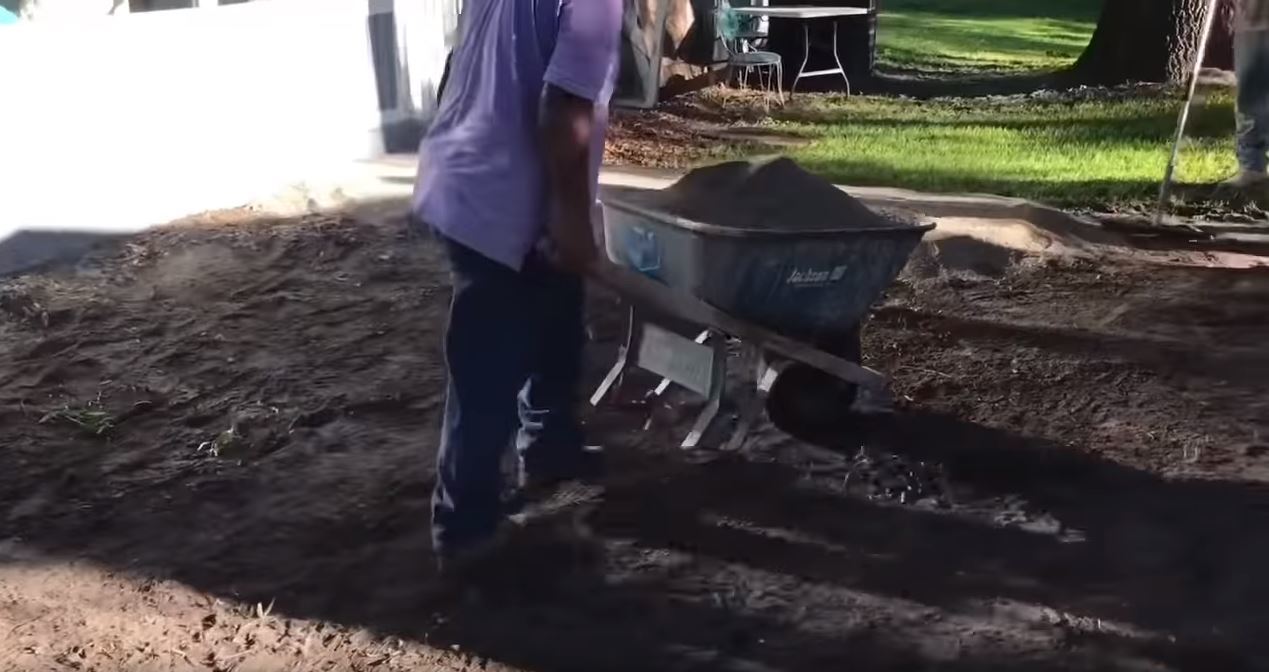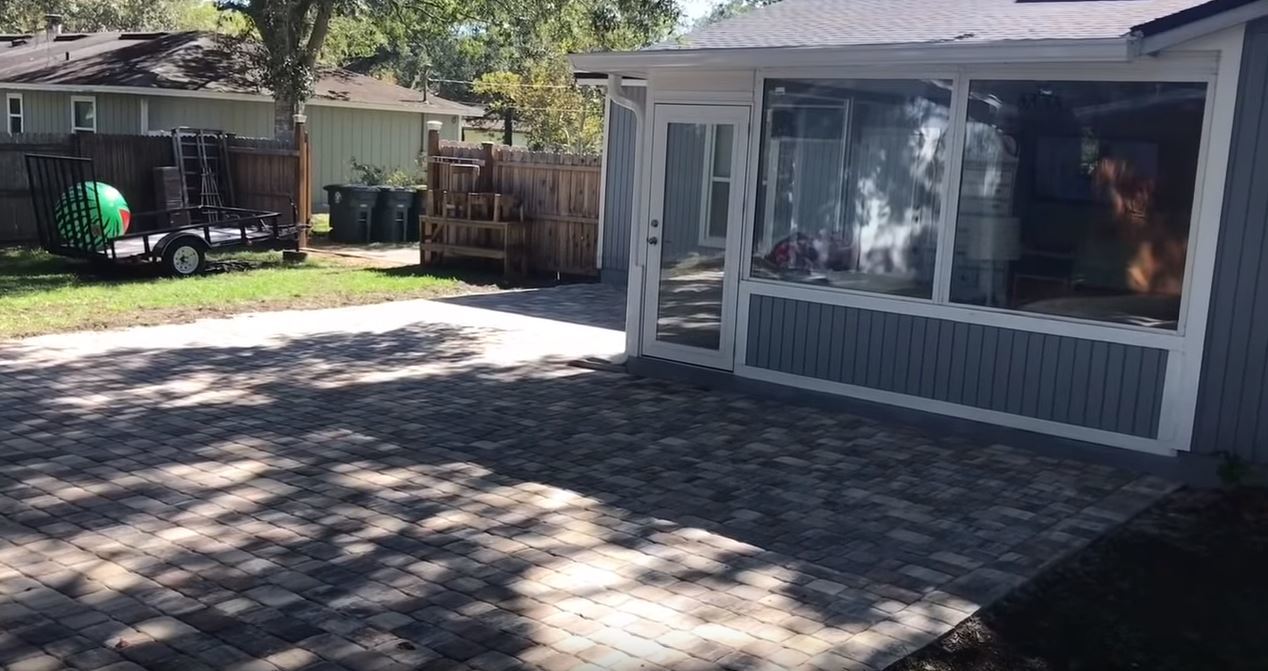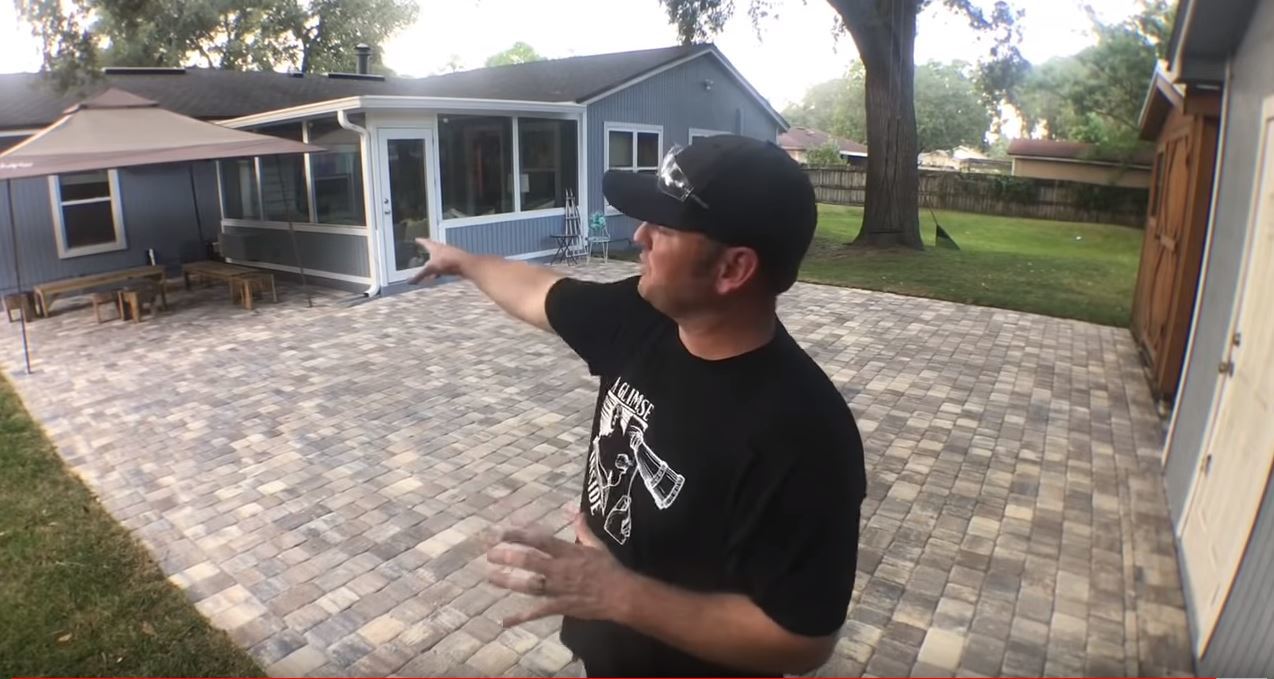Today I am going to take you through how to properly install a brick courtyard.
It's around 1200 square feet and it's pretty amazing.
Firstly let me say this is not my work, I have based it on a video I found and have tried to keep it pretty simple. This is just to give you a working idea of how to lay brick pavers.
To make this courtyard, a crew of four came in and within just seven hours laid 1200 square feet of pavers and I am going to explain just how they did it.
Steps to Pave a Brick Courtyard
Step number one, paver base. They got this delivery to the house and then dumped it here on the driveway. A paver base is essentially reclaimed concrete that's been crushed and pulverised then mixed with a little bit of brand-new concrete.
In Australia, we often call this road base.
It's going to go down as the supporting layer. As you can see here this backyard space has seen better days and these brick pavers are going to transform it into a real welcoming and useful area.
The workmen start grading the property with essentially just shovels, taking out the first layer of weeds and grass and the four of them get this finished in about 15 minutes.

Removing The Top Layer Of Debris

Clearing The Top Layer
One guy applies paver base to the ground and you can see it's about three to four inches thick and they're going to scrape it down and grade it with a landscape rake.
A quick side note here, this is not easy work.
They make it look so easy, they make the process go so quickly and so effortlessly but it is not easy at all, so my hat's off to these gentlemen for working so hard.

Delivering The Paver Base

Laying The Paver Base Out
Now that the paver-base is installed, it's time to do one final grading before they compress it into the ground. This is a landscape skill and honestly, there is a subtle nuance to this, there's a kind of art form to grading the paver base with a one-inch fall, for every 10 feet slope away from the house.
You can't even tell this by eye but these guys did a great job and during the following rainstorm the owner did notice that the drainage was perfect.

Spreading Out The Base

Making It Level
Time to compact the paver base into the ground. This compactor is about 14-inch wide and is going to make quick work of this job. You can do this by hand but this machine makes it so much faster. 3,000 psi all the way to the ground and we are good to go. It is loud though so pick your time to keep neighbours on side.

Wacker Or Compactor

Doing A Great Job
Time to compact the paver base into the ground. This compactor is about 14-inch wide and is going to make quick work of this job. You can do this by hand but this machine makes it so much faster. 3,000 psi to the ground and we are good to go. It is loud though so pick your time to keep neighbours on your good side.
As you can see here, the border pieces are put up against the house and a chalk line is snapped down. They do the same thing on the other side of the house as well and now with a four-foot level, he's going to kind of scuff up the first half-inch or so of the paver base.
When they start laying these down, as compact and as compressed as this paver base is, they'll need a little bit of wiggle room for these pavers to nestle themselves in and that's why they loosen up the material.

One Paver Off The Building As A Boarder

Same On The Other Side

Starting The Laying

Is There A Pattern?
As these pavers are being laid down, I'm kind of watching the workmen do this pattern and I'm trying to realise what pattern they are using—is there a pattern to these bricks?
I see there are three different sizes but I can't figure out exactly how they know what goes where. The workman explains that there is no pattern, it's chaotic and random, which ends up being more pleasing to the eye.
I'll explain this in a minute but it's pretty mesmerising to watch this thing go down. The cameraman then goes into the shed just for a second to explain this system of pavers.

The Pavers

Three Different Sizes
There are three different sizes of paver.
They are all six and a quarter inches wide, however, one nine and a quarter inches long. There is a six and a quarter by six and a quarter square and then a four and three quarter by six and a quarter.
Now all those measurements may seem unorganised, but they all come together and are engineered this way so a chaotic pattern is what you get. When you're laying down pavers you can choose what you like but some people don't want a simple brick pattern or something that repeats itself.
It's much more pleasing on the eye to have a very chaotic pattern throughout, but the cool thing is about these three measurements is that they will all essentially line up and I'll show you where they'll line up together no matter how long of a track you run they all line up in a straight line giving you a nice area to border as you see here one two three as it goes down so a lot of engineering that goes into making these things.
If you look to the bottom left of the screen you can see the six by nine pavers are oriented 90 degrees to the patio. These are used specifically for not just inside the actual paver patio but they're going to use these 90 degrees to make a border around the entire thing.
And look at that, essentially a third of the paver patio is completed and it's only 9:30 in the morning. It's been about an hour and a half, I kid you not, this crew is really rocking.

Moving At A Cracking Pace

Almost Done
Now putting a border on these pavers up to grass is pretty easy but when you have a building involved, you have to make some cuts in the pavers. Looking at the edge of the house they are trying to incorporate some of the plumbing pipes which is going to mean cutting with the saw again, however, it's coming together really nicely and right now it's about 12:30 - 1:00 o'clock these guys have been working all day and I have to say I'm thoroughly impressed.
Essentially these guys are artisans and they are doing a fantastic job.

Using A Brick Cutter To Allow Boarder

Brick Cutter

Putting Boarder Up To House
Now with all the pavers completely laid in, the workmen take away some of the soil from the edge and leave a little gap underneath.
Why?
Well they're going to mix up some concrete and shove that in that gap just to give the edge of the paver patio some rigidity and some strength and of course they'll come back with a trowel and make it nice and smooth and then eventually just put some topsoil up against it and lay some sod as you'll see in the end of the video it looks pretty good.
At this point it is just time to cut around the pipes and fill in the area. In the end it looks great. Using a brick saw is the best way to cut into pavers and they are available at any rental place.

Trim Bricks For Pipes

Trim Bricks For Pipes
The final touches they're going to take some of this sand and glaze it over the entire surface of the paver patio. At this point they take the compactor again and compress those pavers down into that paver base on top of the same.
So this paver patio is 1,200 square feet which is fairly large in size but the owner wanted to do something in the backyard for his family to be able to hang out and the kids are going to have a wonderful area to go out and spend time in.
The last step in the process is to flood the surface with the sand on it and to glue or brush the sand into all those nooks and crannies and what you get is a paver patio that is sturdy and will last for years and years. Quite frankly it is going to improve the living space for the better for years to come.
So there we go. All done. In this case (with four workmen) the job was finished in around six hours. But if you were doing it yourself I would estimate maybe 18 to 24 hours.

Finished Courtyard

Finished Courtyard 2
Is it worth it. You tell me? I think so.
I think it turns a grubby, primarily unusable backyard into one that has heaps of potential.
Paving is the best way to take areas that are hard to use or expensive to keep nice and make them very usable and cheap to maintain. Think of how your backyard could look like with an awesome brick courtyard boxed in by artisan brick walls.
Until next time!















